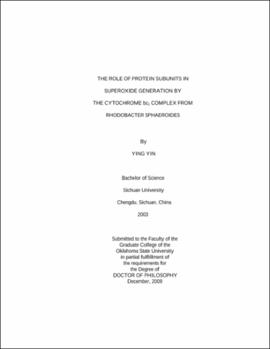| dc.contributor.advisor | Yu, Chang-An | |
| dc.contributor.author | Yin, Ying | |
| dc.date.accessioned | 2013-11-26T08:23:00Z | |
| dc.date.available | 2013-11-26T08:23:00Z | |
| dc.date.issued | 2009-12 | |
| dc.identifier.uri | https://hdl.handle.net/11244/6685 | |
| dc.description.abstract | Scope and Method of Study: | |
| dc.description.abstract | The electron transfer activity of three-subunit core cytochrome bc1 complex from Rhodobacter sphaeroides has only one fourth that of the wild type enzyme. The addition of subunit IV to the core complex restores the activity to the same level as that of wild type. Why does the lack of subunit IV make such difference? What is the essential residue of subunit IV for the reconstitutive activity? What is the role of subunit IV during bc1 catalysis. The proteinase K treated complex has the maximum superoxide production. What produces superoxide anion after the digestion? To answer these questions, we constructed various mutants of subunit IV, and in vitro reconstitute them to the core complex, meanwhile bc1 activity assay, SDS-PAGE, DSC, and in vitro binding assay were used. We also measured the pre-steady state reduction rate of cytochrome b and c1, as well as the superoxide generation by bc1 complex and different oxidant in the presence of phospholipids vesicles or detergents. | |
| dc.description.abstract | Findings and Conclusions: | |
| dc.description.abstract | Our results suggested that a region of subunit IV containing residues 77-85 is essential for the interaction with the core complex to restore the bc1 activity. Residues 81- 84 are required for reconstitutive activity of subunit IV. The core complex produces four times as much superoxide anion as does the wild-type enzyme. The subunit IV decreases the electron leakage from the QP pocket during bc1 catalysis. The oxidation of ubiquinol by a high potential oxidant such as cytochrome c and ferricyanide in the presence of phospholipid vesicles or micellar solution of detergent results in the generation of superoxide. This suggested that superoxide generation from oxidation of ubiquinol only requires a high potential oxidant and hydrophobic environment. | |
| dc.format | application/pdf | |
| dc.language | en_US | |
| dc.rights | Copyright is held by the author who has granted the Oklahoma State University Library the non-exclusive right to share this material in its institutional repository. Contact Digital Library Services at lib-dls@okstate.edu or 405-744-9161 for the permission policy on the use, reproduction or distribution of this material. | |
| dc.title | Role of protein subunits in superoxide generation by the cytochrome bc1 complex from Rhodobacter sphaeroides | |
| dc.contributor.committeeMember | Yu, Linda | |
| dc.contributor.committeeMember | Burnap, Robert Lord | |
| dc.contributor.committeeMember | Matts, Robert L. | |
| dc.contributor.committeeMember | Mort, Andrew J. | |
| osu.filename | Yin_okstate_0664D_10615.pdf | |
| osu.accesstype | Open Access | |
| dc.type.genre | Dissertation | |
| dc.type.material | Text | |
| thesis.degree.discipline | Biochemistry and Molecular Biology | |
| thesis.degree.grantor | Oklahoma State University | |
